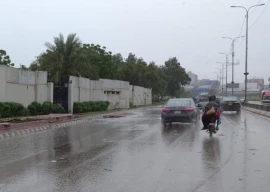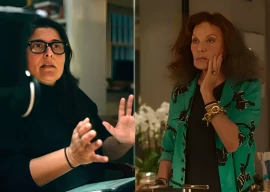
KARACHI: While some people like to imagine Karachi as an organic entity that is perpetually growing outward, quality patient care unfortunately remains confined to its nucleus.
The hospitals in Malir that line the National Highway near Kala Board are the closest medical facilities for patients coming from Bin Qasim and other localities in Malir and Landhi. The institutes are wedged between an odd assortment of makeshift food, juice and paan stalls, schools and quite amusingly, homeopathy clinics. Some of the more well-known names are Nehal Hospital, Al-Mumtaz Medical Complex, Atia Hospital, Dr Atique Orthopedic and Medical Centre and Hasan General Hospital.
At first glance the hospitals seem like fairly decent places to pop in for treatment - after all, they look quite pristine. But only when you step inside and ask for specialists do you realise that something is amiss: most of the out-patient departments open in the afternoon because the specialists are busy tending to patients in one of the bigger hospitals in the city centre.
Nazia, a resident of Gulshan-e-Hadeed, learnt this the hard way. She wanted to see a chest specialist and made her way to Nehal Hospital. No dice. A family friend, who worked as a physician at the adjacent Al-Mumtaz Medical Complex, said that there were three at his hospital. When she finally made her way down there, she was dismayed to learn that the best physician would arrive five hours later. The hospital’s help desk told her that an appointment couldn’t be booked and that she would have to get in line. “I live very far away so I will have to wait,” she said.
A pulmonary diseases specialist who sits at one of the hospitals said that he sets aside his mornings to practice at an institute in the city centre. There, the number of patients is much higher than that which visit him in Malir the entire day - a mere 25 people on an extremely busy day.
Local expertise?
Most doctors at the hospitals are armed with only local qualifications and do not have much international exposure - far short of the kind that specialists in the city centre have acquired as amply exhibited on their clinic walls. The doctors who sit downtown have the additional advantage of high volume which gives them more practice and makes them better at their job.
One of the hospitals in Malir proudly displays a list of experts at its entrance. But most of them only have an MBBS degree next to their name. There are only a handful of FCPS or Fellows of the College of Physicians and Surgeons, which is a higher qualification. You would be hard-pressed to find a familiar name in the list of specialists.
This would explain perhaps the low fee of Rs350 to see one. This is about 40% lower than what you pay at hospitals in the city centre. There is an obvious trade-off though. You might be paying less, but you have to forgo convenient timings.
Equipment
The good news is that the hospitals do have ventilators, CT scanners and ultrasound machines, labour rooms, incubators. laparoscopic equipment, and offer endoscopies and colonoscopies. But much of the diagnostic burden is shared with the laboratories mushrooming in the area. Most of the hospitals have an operation theatre, but it is hardly ever used. The hospitals do not have any security either. There are very few relief packages for the poor and they hardly report infectious diseases to the government.
Going the distance
The hospital management constantly complains that the turbulent political landscape of the city has had an adverse impact on patient care. “You cannot separate politics from daily life in many parts of the city and Malir is one of them,” said an administrative officer at one of the hospitals. “We don’t want any drama at our place. Some attendants are so intolerant that they start harassing the doctors when they feel that the patient is in danger,” he said. “We usually refer such cases to other medical facilities.”
At yet another hospital, the entrance is narrow. It has intentionally been built that way so that all the people streaming into the building can be scanned. “Last Friday, five gunshot victims came here,” said the officer, counting them on his fingers. It took the hospital hardly half an hour to staunch the bleeding and tend to the wounds. After the basic first aid was performed, however, their relatives took the injured men away to either Jinnah hospital or Civil hospital to see the specialists. This means then that if a patient has come from a far-flung area, they have to travel an additional 17kms after making a pitstop at a Malir hospital if they want to go to a tertiary care centre downtown.
Published in The Express Tribune, November 3rd, 2012.











































COMMENTS
Comments are moderated and generally will be posted if they are on-topic and not abusive.
For more information, please see our Comments FAQ